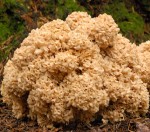 This large mushroom has fleshy cream to pale yellow-brown fruiting body consisting of a multitude of lobes and looks like a brain or sea sponges well as a head of cauliflower. It grows in the temperate regions of eastern North American and the West Coast where it is found from late summer to fall on the roots or stumps of coniferous trees, especially pine and spruce. The mushroom is four to sixteen inches wide and can weigh up to thirty pounds. The lobes of the fruiting body are densely packed, firm, flat and branched, and the tips of the branches are curled giving the mushroom its distinctive look. The spore bearing layer is on only one side of the lobes. The spores are white to pale yellow and the stem is thick and yellowish-white.
This large mushroom has fleshy cream to pale yellow-brown fruiting body consisting of a multitude of lobes and looks like a brain or sea sponges well as a head of cauliflower. It grows in the temperate regions of eastern North American and the West Coast where it is found from late summer to fall on the roots or stumps of coniferous trees, especially pine and spruce. The mushroom is four to sixteen inches wide and can weigh up to thirty pounds. The lobes of the fruiting body are densely packed, firm, flat and branched, and the tips of the branches are curled giving the mushroom its distinctive look. The spore bearing layer is on only one side of the lobes. The spores are white to pale yellow and the stem is thick and yellowish-white.
The cauliflower mushroom is considered edible for its good flavor but should be eaten when young before the flesh becomes elastic and then tough. The shear size of the mushroom makes it a popular edible mushroom, although the nature of the densely packed lobes make them difficult to clean well. The French cultivate it and call it fall morel or just morel but it does not have the superb flavor of a true morel. It’s flavor, however, does complement a cream sauce well.
When collecting mushrooms for the table always seek the aid of an expert since there is at least one look a-like that is poisonous.
Photo Credit: James Lindsey, Wikimedia Commons